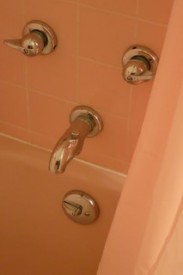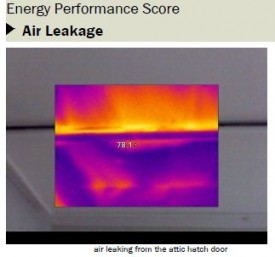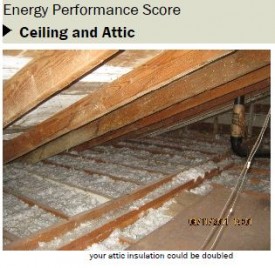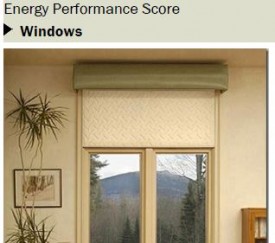My standard fall-through-spring attire includes three layers of shirts (at least one of which is a sweater), jeans, and two pairs of socks. I often wear a scarf, and not a stylish frou-frou scarf that’s knotted to the side, but something knit and chunky and long enough to encircle an elephant.
Did I mention this is what I’m wearing indoors?
So when we bought a new house recently, one of the first things I wanted to do was to make it cozy. Because when I say “new house” I mean new to me, and built in 1951 complete with the original 4 scant inches of attic insulation. My pink bathroom I loved, the single-pane windows that were drafty even when closed, I did not.

I knew my house had energy issues, but what exactly were they, and which ones were most cost effective to fix? I needed help from the pros.
Happily, my esteemed Sightline colleague Jen Langston had reported that in Seattle, a professional energy audit is cheap and easy to come by. That’s because Seattle City Light offers subsidized audits – like $95 out of pocket when the assessment would normally cost about $400, plus you get a truckload of fluorescent bulbs for free. And the city has a list of certified folks to do the work, so you don’t have to do a lot of research hunting for someone reliable.
So I took the first step. I browsed the list and contacted Revolution Green Power because they were located in the Northend, nearish my house.
You say you want a revolution
Shortly after my initial contact, Revolution Green Power co-owners Gordon Smith and Kevin Ward, plus an employee, arrived at my house with tool kits filled with fancy gear. Then they examined my house from basement to rooftop.
I cringed and apologized for some features — the rec-room fridge, the attractive-but-not-insulating blinds, the multitude of incandescent bulbs. But Smith and Ward made it clear they weren’t there to judge, but to make an honest assessment of what cost-effective fixes I could make to shrink my power and carbon footprints.
The three of them spent about four hours at the house, peeking into fireplaces, exploring the attic, examining the furnace, and making notes about it all. Then they had me close all of the windows and fireplace dampers. They set a fan inside our downstairs door and sealed it in place. Then they did this neat trick called a “blower door test.” This is how it works:
A blower door is a powerful fan that mounts into the frame of an exterior door. The fan pulls air out of the house, lowering the air pressure inside. The higher outside air pressure then flows in through all unsealed cracks and openings. The auditors may use a smoke pencil to detect air leaks. These tests determine the air infiltration rate of a building.
I had been told that electrical outlets leak heat to the outside, but it’s hard to believe it amounts to much until you feel an actual breeze coming in through it.

Then there was the chimney. Even with the damper fully closed, sitting next to the fireplace felt like I was driving down the street with my car window rolled all the way down. It wasn’t just drafty, it was practically windy.
I had work to do.
Then Smith walked around the house with his secret-agent thermal-imaging camera. This expensive and super cool device illustrated in screaming shades of magenta and orange how much heat was being lost through the door to our attic and the recessed light cans in our kitchen ceiling.
The truth hurts when viewed in rainbow hues and with oh-so-apparent breezes. But this was information I wanted, and the audit so tangibly highlighted problems that can easily go undetected and ignored.
Here’s the score
About a week after their visit, Revolution Green Power sent me two reports. One was an energy-consumption scorecard that showed how our house stacked up against the average Seattle home, as well as how we’d score if we made some upgrades.
Unfortunately, we were well above average, generating about 10 tons of carbon pollution a year. With their prescribed efficiency improvements, we could drop to 6 tons a year which still sounds like A LOT but is below the 8.8 ton city average and also below Seattle’s greenhouse gas emissions goal for 2024.

The other document was the Energy Analysis Report, which went into detail about our existing home and specific fixes we could make to improve it. I love this report, despite my bad showing. First it offers a report-card style assessment of my home’s energy elements — attic insulation energy-efficient appliances, ducts, windows, etc. In a glance my trouble areas were quickly revealed by scores of poor or very poor. They included the attic, floor and foundation insulation, and lights and appliances.
Then it gave me an at-a-glance, “bang for your buck” analysis by showing the approximate costs for improvements in each of the areas, how much money I could expect to recoup annually, and life-time carbon savings.

The report then went on to address each of the elements in detail, explaining our current situation and the easy/less expensive fixes and the more costly options. It had lots of detail, down to how many inches of insulation we need and the best brands for some items. This was perfect. I truly want to think about this as little as humanly possible, but still make good decisions, and this report allows me to do that.
Now, which steps to take?
It’s getting hot in here

I already knew based on our inspection before buying the house that I needed to get more insulation for the attic. But the assessment also pointed out the need to create an insulating hatch for the drop-down attic door. We used Einar Johanson Insulation and Glass, a highly recommended Ballard-based company, that did a great job, tripling our insulation to approximately 1 foot. Revolution Green Power also bid the job, but came in slightly higher and we also used Johanson for some window work. Another bonus: Puget Sound Energy, our natural gas supplier, gave us a $400 credit for getting the insulation work done.
Other ideas I particularly liked:
A chimney balloon: It’s exactly what it sounds like. The balloon is inflated inside your chimney flue to provide a big old air pillow of insulation. The nice thing is that it can be deflated and removed if you want to use your fireplace. The smaller kicker is that despite Santa drawings to the contrary, chimneys are not always lovely straight conduits to the sky but bending sooty tunnels that are somewhat challenging to measure. That said, I was able to persuade my husband to don a headlamp and stick his head in there to measure the opening and now I have a balloon installed.
Storm windows: I already knew that replacing low efficiency windows with high efficiency ones doesn’t save a lot of power compared to other, less gratifying improvements like adding insulation to the ceiling. We replaced some of our worst windows anyhow. But for others, Smith and Ward advised us that installing wood-framed storm windows can provide even more benefit than new double-paned windows for less cost. We did get a couple of storms and I’m looking forward to doing more in the future.
Outlet insulation and weather stripping: These are easy fixes. I need to remove the outlet faceplate and install a rectangle of foam insulation or spray the stuff in. I know I can just buy a roll of weather stripping and seal up some drafty doors. I still haven’t done this, but plan to.

Window quilt: Doesn’t that sound so cozy? Smith and Ward recommended either buying a window quilt or making them using “Warm Window” fabric available at Jo-Ann Fabric. It’s apparently “quilted material with Mylar sandwiched in the middle, which can be sewn to any fabric of your liking. It keeps the heat in a room in the winter and also reflects the heat out of a room in the
summer.” I like this idea because I hate cold windows at night, but I haven’t mustered up the motivation to figure out a way to make this work for my fancy shades.
The one note of caution to all of this work is that you can make your house so air-tight that you don’t get enough circulation with outside air and that can lead to indoor air pollution. But because this audit was so wonderfully holistic, that fact was taken into account and my Revolution Green Energy pals suggested installing a better ceiling fan in one or more of my bathrooms to make sure enough air is exchanged. Again, they even had a brand and model that I just need to plug into Amazon.
There’s also a great Seattle-based program called Community Power Works that’s helping homeowners cut their energy use. Community Power Works helps folks pay for upgrades and find reliable contractors to do the work. Basically, it’s designed to hold your hand and guide you through the process. Revolution Green Power is part of the program, as are other skilled auditors and contractors.
And Seattle isn’t alone in offering subsidized energy efficiency audits. Contact your local power or fuel provider to see if they offer any rebates for audits or upgrades. For big picture information, Oregon’s Department of Energy has efficiency information available, as does the Oregon Environmental Council. The state of Washington also has energy consumption curbing tips.
Oregon Public Broadcasting recently had a short piece on the effort to make low-income homes more energy efficient. Already 16,000 Washington homes have been upgraded in the three years that the federally-funded Weatherization Assistance Program has operated.
There remain more expensive improvements for us to consider: installing insulation on top of our basement floor, upgrading our washer-dryer, refrigerator, etc. with energy-efficient models, eventually replacing our natural gas furnace with a heat pump. We won’t be racing out to make these changes, but as appliances wear out or opportunities arise, it’s nice to know what we’re striving for.
In the meantime, I already feel snugglier in my better insulated, semi-storm windowed, chimney-ballooned abode. Thank goodness that Seattle City Light offers a subsidized program to make it easy and affordable for residents to get a grip on their energy issues.


Comments are closed.